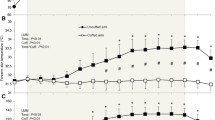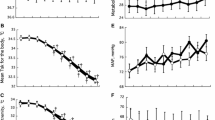Abstract
To elucidate the characteristics of vasomotor control in glabrous and nonglabrous skin during dynamic exercise, we compared the vascular responses in both areas to increasing core temperature during the cycle exercise for 30 min at different intensities in the range 20–60% of peak oxygen consumption (VO2peak) in a total of 13 male and four female subjects in two experimental protocols. Skin blood flow was monitored using laser Doppler flowmetry. In protocol 1, the slope of the relationship between esophageal temperature (T es) and cutaneous vascular conductance (CVC) in the early phase of the exercise decreased (P < 0.05) with increasing exercise intensity at glabrous sites (palm) but not nonglabrous sites (dorsal hand). In protocol 2, to examine whether a difference in vascular responses in the two areas is due to the adrenergic vasoconstrictor system, the release of norepinephrine from adrenergic nerves in forearm and palmar skin was blocked locally by iontophoresis of bretylium tosylate (BT). The administration of BT diminished completely the change of CVC in the palm during the exercise but did not alter the response in the forearm compared with the untreated site. In the two areas, neither the T es threshold for vasodilation nor the change in CVC above the threshold in the middle and late phase of the exercise was influenced by the intensity of the exercise. These results suggest that, in the early phase of the exercise, light-to-moderate exercise reduces in an intensity-dependent manner the thermal sensitivity for vasodilation in glabrous skin but not nonglabrous skin via an adrenergic vasoconstrictor pathway.




Similar content being viewed by others
References
Abramson DI (ed) (1967) Vascular responses in skin: circulation in the extremities. Academic, pp 114–138
Christensen EH, Nielsen M, Hannisdahl B (1942) Investigations of the circulation in the skin at the beginning of muscular work. Acta Physiol Scand 4:162–170
Greenfield ADM (ed) (1963) The circulation through the skin: handbook of physiology. Circulation, Sect 2, vol 2, Chapt 39. American Physiological Society, Washington, pp 1325–1351
Hirata K, Nagasaka T, Hirai A, Hirashita M, Takahara T (1984) Cutaneous vascular tone during heat load modified by exercise intensity. J Therm Biol 9:117–120
Hirata K, Nagasaka T, Hirai A, Hirashita M, Takahara T, Nunomura T (1986) Effects of human menstrual cycle on thermoregulatory vasodilation during exercise. Eur J Appl Physiol 54:559–565
Johnson JM (1979) Responses of forearm blood flow to graded leg exercise in man. J Appl Physiol 46:457–462
Johnson JM (1986) Nonthermoregulatory control of human skin blood flow. J Appl Physiol 61:1613–1622
Johnson JM (1992) Exercise and cutaneous circulation. Exerc Sport Sci Rev 20:59–97
Johnson JM, Park MK (1981) Effect of upright exercise and on threshold for cutaneous vasodilation and sweating. J Appl Physiol 35:814–818
Johnson JM, Park MK (1982) Effect of heat stress on cutaneous vascular responses to the initiation of exercise. J Appl Physiol 53:744–749
Johnson JM, Proppe DW (eds) (1996) Cardiovascular adjustments to heat stress. In: Handbook of physiology: environmental physiology. Oxford University Press, New York, pp 215–243
Johnson JM, Taylor WF, Shepherd AP, Park MK (1984) Laser-Doppler measurement of skin blood flow: comparison with plethysmography. J Appl Physiol 56:798–803
Johnson JM, Pérgola PE, Liao FK, Kellogg DL Jr, Crandall CG (1995) Skin of the dorsal aspect of human hands and fingers possesses an active vasodilator system. J Appl Physiol 78:948–954
Kellogg DL Jr, Johnson JM, Kosiba W (1989) Selective abolition of adrenergic vasoconstrictor responses in skin by local iontophoresis of bretylium. Am J Physiol 257:H1599–H1606
Kellogg DL Jr, Johnson JM, Kosiba WA (1991) Competition between cutaneous active vasoconstriction and active vasodilation during exercise in humans. Am J Physiol 261:H1184–H1189
Kellogg DL, Pérgola PE, Piest KL, Kosiba WA, Crandall CG, Johnson JM (1995) Cutaneous active vasodilation in humans is mediated by cholinergic nerve cotransmission. Circ Res 77:1222–1228
Kondo N (1999) The control of sweating rate and skin blood flow during exercise. In: Nose H, Gisolfi CV, Imaizumi K (eds) Exercise, nutrition, and environmental stress, vol 1. Cooper, Traverse City, pp 153–178
Kondo N, Takano S, Aoki K, Shibasaki M, Tominaga H, Inoue Y (1998) Regional differences in the effect of exercise intensity on thermoregulatory sweating and cutaneous vasodilation. Acta Physiol Scand 164:71–78
Mack GW, Nose H, Takamata A, Okuno T, Morimoto T (1994) Influence of exercise intensity and plasma volume on active cutaneous vasodilation in humans. Med Sci Sports Exerc 26:209–216
Mitono H, Endoh H, Okazaki K, Ichinose T, Masuki S, Takamata A, Nose H (2005) Acute hypoosmolality attenuates the suppression of cutaneous vasodilation with increased exercise intensity. J Appl Physiol 99:902–908
Rowell LB (1983) Cardiovascular aspects of human thermoregulation. Circ Res 52:367–379
Saad AR, Stephens DP, Bennett LAT, Charkoudian N, Kosiba WA, Johnson JM (2001) Influence of isometric exercise on blood flow and sweating in glabrous and nonglabrous human skin. J Appl Physiol 91:2487–2492
Smolander J, Saalo J, Korhonen O (1991) Effect of work load on cutaneous vascular response to exercise. J Appl Physiol 71:1614–1619
Takeno Y, Kamijo Y, Nose H (2001) Thermoregulatory and aerobic changes after endurance training in a hypobaric hypoxic and warm environment. J Appl Physiol 91:1520–1528
Taylor WF, Johnson JM, O’Leary D, Park MK (1984a) Effect of high local temperature on reflex cutaneous vasodilation. J Appl Physiol 57:191–196
Taylor WF, Johnson JM, O’Leary D, Park MK (1984b) Modification of the cutaneous vascular response to exercise by local skin temperature. J Appl Physiol 57:1878–1884
Taylor WF, Johnson JM, Kosiba WA, Kwan CM (1988) Graded cutaneous vascular responses to dynamic leg exercise. J Appl Physiol 64:1803–1809
Wenger CB, Roberts MF, Stolwijk JAJ, Nadel ER (1975) Forearm blood flow during body temperature transients produced by leg exercise. J Appl Physiol 38:58–63
Yamazaki F (2002) Vasomotor responses in glabrous and nonglabrous skin during sinusoidal exercise. Med Sci Sports Exerc 34:767–772
Yamazaki F, Sone R (2003a) Evaluation of thermoregulatory responses during exercise and exercise prescription. In: Nose H, Mack G, Imaizumi K (eds) Exercise, nutrition, and environmental stress, vol 3. Cooper, Traverse City, pp 155–177
Yamazaki F, Sone R (2003b) Skin vascular response in the hand during sinusoidal exercise in physically trained subjects. Eur J Appl Physiol 90:159–164
Yanagimoto S, Kuwahara T, Zhang Y, Koga S, Inoue Y, Kondo N (2003) Intensity-dependent thermoregulatory responses at the onset of dynamic exercise in mildly heated humans. Am J Physiol 285:R200–R207
Acknowledgments
We thank M. Endo and T. Matsui for technical assistance and cooperation. Appreciation is also expressed to the participants in this study.
Author information
Authors and Affiliations
Corresponding author
Rights and permissions
About this article
Cite this article
Yamazaki, F., Sone, R. Different vascular responses in glabrous and nonglabrous skin with increasing core temperature during exercise. Eur J Appl Physiol 97, 582–590 (2006). https://doi.org/10.1007/s00421-006-0219-4
Accepted:
Published:
Issue Date:
DOI: https://doi.org/10.1007/s00421-006-0219-4




